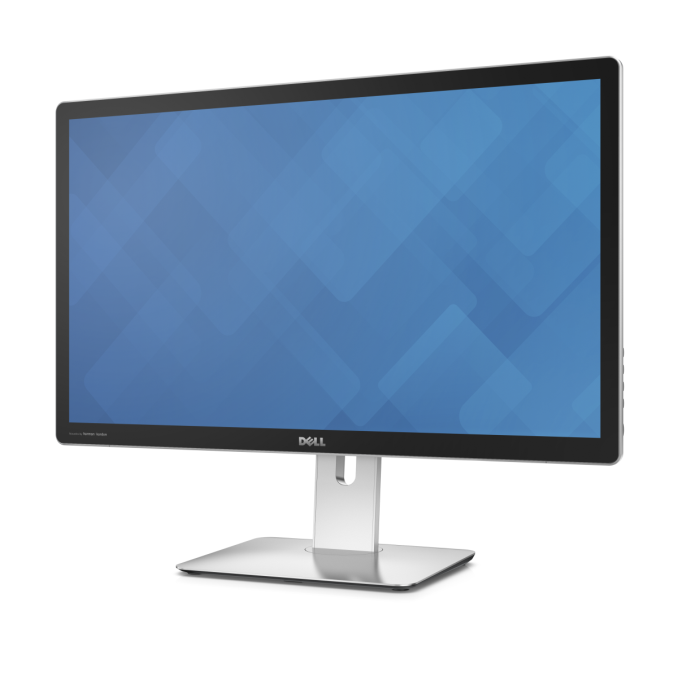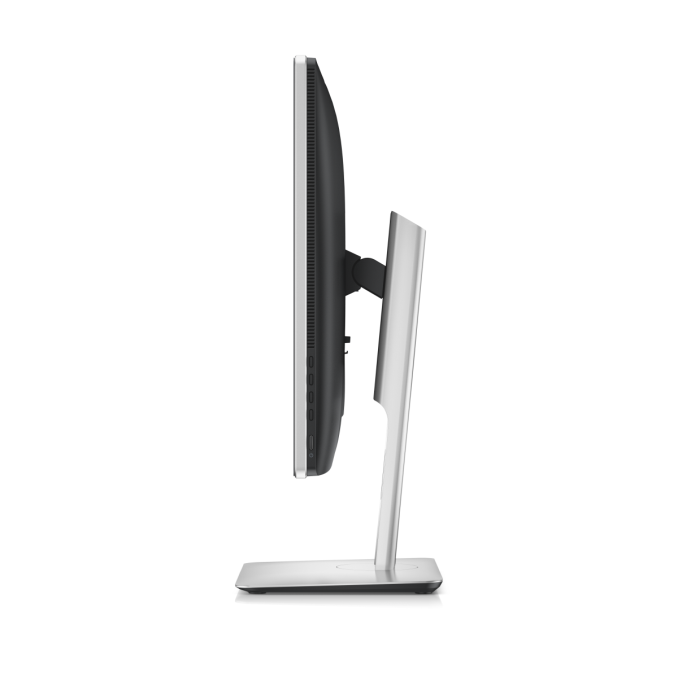Dell Previews 27-inch ‘5K’ UltraSharp Monitor: 5120x2880
by Ian Cutress on September 5, 2014 3:16 AM EST- Posted in
- Displays
- Dell
- Monitors
- 5K
- Ultrasharp
_678x452.png)
UHD is dead. Not really, but it would seem that displays bigger than UHD/4K will soon be coming to market. The ability of being able to stitch two regular sized outputs into the same panel is now being exploited even more as Dell has announced during its Modern Workforce livestream about the new ‘5K’ Ultrasharp 27-inch display. The ‘5K’ name comes from the 5120 pixels horizontally, but this panel screams as being two lots of 2560x2880 in a tiled display.
5120x2880 at 27 inches comes out at 218 PPI for a total of 14.7 million pixels. At that number of pixels per inch, we are essentially looking at a larger 15.4-inch Retina MBP or double a WQHD ASUS Zenbook UX301, and seems right for users wanting to upgrade their 13 year old IBM T220 for something a bit more modern.
| Displays Sorted by PPI | ||||
| Product | Size / in | Resolution | PPI | Pixels |
| LG G3 | 5.5 | 2560x1440 | 534 | 3,686,400 |
| Samsung Galaxy S5 | 5.1 | 1920x1080 | 432 | 2,073,600 |
| HTC One Max | 5.9 | 1920x1080 | 373 | 2,073,600 |
| Apple iPhone 5S | 4 | 640x1136 | 326 | 727,040 |
| Apple iPad mini Retina | 7.9 | 2048x1536 | 324 | 2,777,088 |
| Google Nexus 4 | 4.7 | 1280x768 | 318 | 983,040 |
| Google Nexus 10 | 10 | 2560x1600 | 300 | 4,096,000 |
| Lenovo Yoga 2 Pro | 13.3 | 3200x1800 | 276 | 5,760,000 |
| ASUS Zenbook UX301A | 13.3 | 2560x1440 | 221 | 3,686,400 |
| Apple Retina MBP 15" | 15.4 | 2880x1800 | 221 | 5,184,000 |
| Dell Ultrasharp 27" 5K | 27 | 5120x2880 | 218 | 14,745,600 |
| Nokia Lumia 820 | 4.3 | 800x480 | 217 | 384,000 |
| IBM T220/T221 | 22.2 | 3840x2400 | 204 | 9,216,000 |
| Dell UP2414Q | 24 | 3840x2160 | 184 | 8,294,400 |
| Dell P2815Q | 28 | 3840x2160 | 157 | 8,294,400 |
| Samsung U28D590D | 28 | 3840x2160 | 157 | 8,294,400 |
| ASUS PQ321Q | 31.5 | 3840x2160 | 140 | 8,294,400 |
| Apple 11.6" MacBook Air | 11.6 | 1366x768 | 135 | 1,049,088 |
| LG 34UM95 | 34 | 3440x1440 | 110 | 4,953,600 |
| Korean 27" WQHD | 27 | 2560x1440 | 109 | 3,686,400 |
| Sharp 8K Prototype | 85 | 7680x4320 | 104 | 33,177,600 |
Dell has been pretty quiet on the specifications, such as HDMI or DisplayPort support, though PC Perspective is reporting 16W integrated speakers. If the display is using tiling to divide up the transport workload over two outputs, that puts the emphasis squarely on two DP 1.2 connections. There is no mention of frame rates as of yet, nor intended color goals.
Clearly this panel is aimed more at workflow than gaming. This is almost double 4K resolution in terms of pixels, and 4K can already bring down the majority of graphics cards to their knees, but we would imagine that the content producer and prosumer would be the intended market. Word is that this monitor will hit the shelves by Christmas, with a $2500 price tag.
Source: Dell




_thumb.png)
_thumb.png)
_thumb.png)
_thumb.png)
_thumb.png)
_thumb.png)








75 Comments
View All Comments
efficacyman - Friday, September 5, 2014 - link
Finally some innovation in desktop displays. I would also like to see a 21:9 1600p monitor come out now that we are finally doing high dpi monitors. Preferrably a lightboost 144hz 21:9 for optimum gaming with only one display.meacupla - Saturday, September 6, 2014 - link
to nit pick, those aren't 'innovations', but rather 'evolution'ABR - Friday, September 5, 2014 - link
So in the early 1990's the NeXTStation Color came out with a "Megapixel Display". A typical configuration ran at 25 MHz, had 16 MB memory, and maybe 500 MB disk. Nowadays a PC "workstation" will run 3-4 GHz with more IPC and multicore, call that a 1000x improvement, with a TB or two of disk (2000x), and anywhere from 16 gig on up of main memory -- another 1000x. But this monitor has what, _fifteen_ times the pixels of that NeXTStation, and we're nominating it for extreme sports categories! Interesting times indeed... (And BTW you could play Doom on that NeXT, so don't say its video card had to do anything less.)MikeMurphy - Sunday, September 7, 2014 - link
Ironically you can thank the same person running NeXT at the time for the recent spike in resolutions - Steve Jobs via Apple.frostyfiredude - Sunday, September 7, 2014 - link
Maybe for marketing by raising awareness, but not from a technical standpoint. Both Android and Windows devices had HiDPI options prior to iOS and OSX respectively.BGQ-qbf-tqf-n6n - Monday, September 8, 2014 - link
That's a negative on the Windows. Mac OS X frameworks were far more high-DPI aware 2003-2008 while Windows XP was still struggling to display non-96 PPI. Apple's vector-based UI model was incredibly forward-looking for the time, although the Retina/2X model came later.Only with Vista/DWM/WPF did Microsoft finally start to catch up (still didn't close the gap until 2012/Windows 8 new-HiDPI support, really).
rajeshk4u - Sunday, April 26, 2015 - link
I am running my 4K on Windows XP. I have no idea what you people have said....coolhardware - Sunday, September 7, 2014 - link
Here is the NeXTStation Megapixel Display vs the Dell 5K: http://pixensity.com/list/desktop/But does anybody know the actual diagonal screen size of the NeXT? (was it really 17 inchces?)
pixelstuff - Friday, September 5, 2014 - link
For monitors like this the OS needs to become aware of the screen size and then apps need to be developed in inches or centimeters so if a button should be 1/2 inch or 1/4 inch the OS can automatically draw it the same size regardless of the PPI in various screens.The OS would probably need some kind of average viewing distance knowledge as well so it can cope with TVs, desktop monitors, and tablets. As well as a way to automatically or quickly switch between those distances once phones and tablets become the universal computing device that you plug into any screen.
When is this going to happen?
DanNeely - Saturday, September 6, 2014 - link
when enough of them are sold to convince developers to start updating them. win32 is too old and doing DPI aware software in it's a pain; but WPF (the new UI framework launched with .net 3.5 in 2008) and it's decendent in win8 both are designed to play nicely with varying DPI levels. It just requires convincing the PHBs and bean counters to spend the time and money needed to rewrite the UI from scratch.